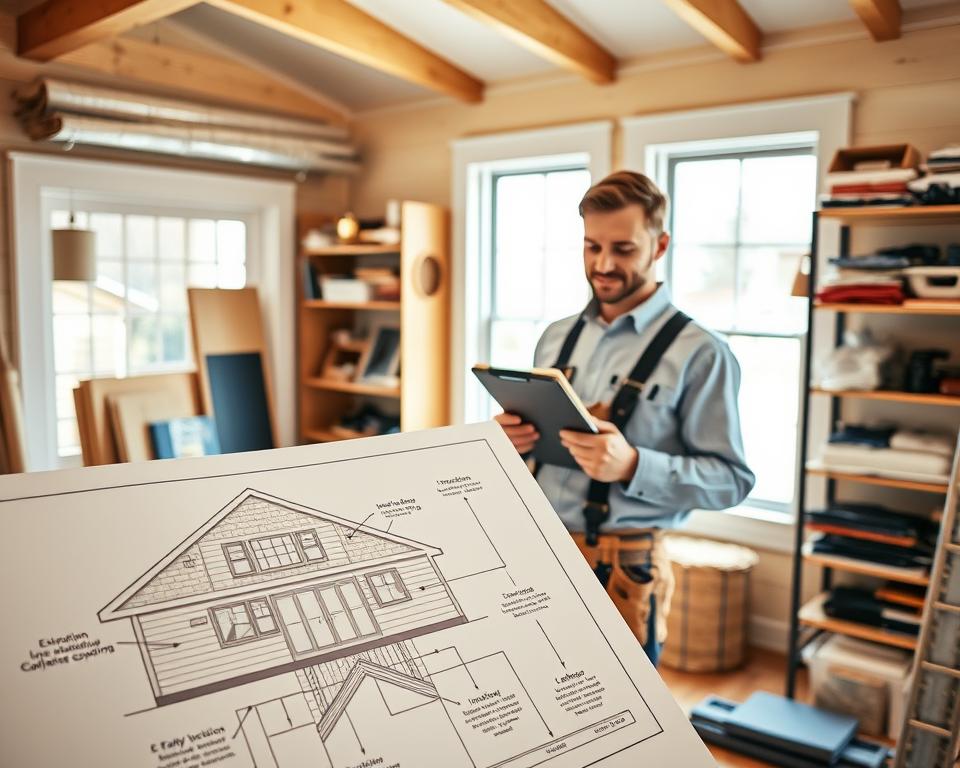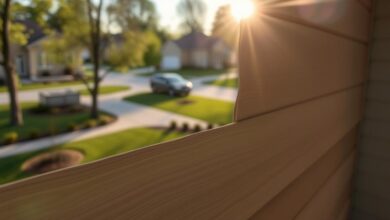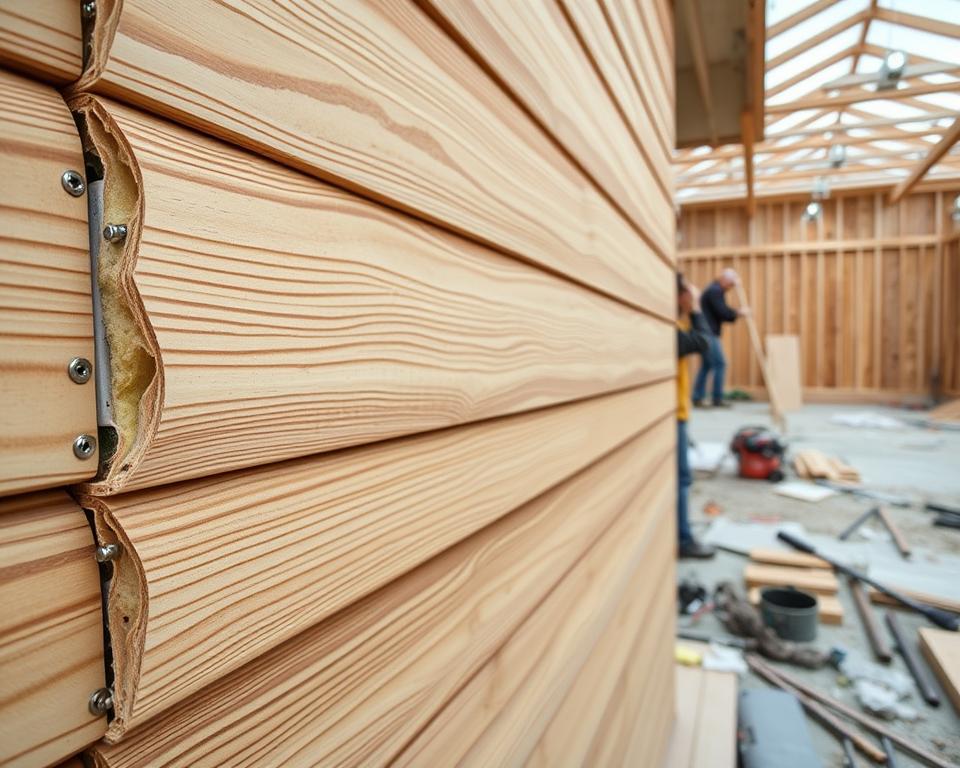Insulated Siding for Noise Reduction: A Guide
Noise pollution is a big problem for homeowners, making their lives less peaceful. Reducing unwanted noise can make homes more comfortable and quiet.
Insulated siding is a great way to reduce noise. It not only blocks sound but also saves energy. Homeowners can have a quieter home and lower energy bills.
This guide will show how insulated siding helps with noise reduction and its benefits for homeowners.
Key Takeaways
- Insulated siding is an effective solution for noise reduction.
- It offers additional benefits, including energy efficiency.
- Homeowners can enjoy a quieter and more comfortable living environment.
- Insulated siding contributes to overall home improvement.
- It’s a practical solution for those looking to reduce noise pollution.
Understanding Noise Pollution in Residential Areas
Noise pollution is a big problem in homes, making life less enjoyable for many. It’s important to know where noise comes from and how it affects us. Solutions like insulated siding can help a lot.
Common Sources of External Noise
External noise can come from many places, including:
- Traffic and highways
- Airports and flight paths
- Neighboring industrial or commercial areas
- Outdoor recreational activities
These sources can greatly increase the noise in a neighborhood.
How Noise Affects Quality of Life
Noise pollution can harm your health and happiness. It can make you stressed, disrupt your sleep, and lower your productivity. Long-term exposure to loud noises can cause even more serious health problems.
Measuring Noise Levels Around Your Home
To grasp the extent of noise pollution, measuring noise levels is key. Homeowners can use a sound level meter to check the noise around their homes.
Knowing the noise levels is the first step to reducing their impact.
Insulated Siding for Noise Reduction: How It Works
It’s important to know how insulated siding works to understand its noise-reducing benefits. This type of siding is made to block outside noise from entering your home. It makes your living space quieter.
The Science Behind Sound Transmission
Sound travels through mediums like air or building materials. Insulated siding reduces noise by absorbing and spreading out sound waves. The insulation layer inside the siding is key to this process.
Sound Transmission Class (STC) Ratings Explained
The Sound Transmission Class (STC) rating shows how well a material blocks sound. A higher STC rating means better soundproofing. For example, siding with an STC rating of 50 or more is very good at blocking noise.
Insulation Materials and Their Acoustic Properties
Insulation materials vary in how well they block sound. Common ones include foam board and fiberglass. These materials soak up sound energy, which helps reduce noise. The type of insulation used affects how well the siding blocks noise.
In short, insulated siding’s ability to block noise comes from its design, STC rating, and insulation materials. Knowing these details helps homeowners choose the right insulated siding for their homes.
Types of Insulated Siding Available
The market has many insulated siding types, each with its own benefits. Homeowners can pick from materials and systems that save energy and reduce noise.
Vinyl Insulated Siding Options
Vinyl insulated siding is loved for its durability and easy care. It has a foam backing for better insulation, making homes more energy-efficient. Vinyl insulated siding comes in many styles and colors, fitting any home.
Fiber Cement Insulated Siding
Fiber cement siding is durable and can be insulated for better performance. It resists pests and fire, making it a solid choice. With insulation, fiber cement siding keeps homes safe from harsh weather.
Foam-Backed Siding Systems
Foam-backed siding systems have foam insulation built into the siding. This creates a solid thermal barrier. The foam-backed siding works well in very hot or cold climates.
Comparing R-Values and STC Ratings
When picking insulated siding, look at R-values and STC ratings. R-values show how well siding insulates, while STC ratings measure noise reduction. Higher R-values mean better insulation, and higher STC ratings mean less noise.
- R-values range from R-2 to R-4 for most insulated siding products.
- STC ratings can vary significantly, with some products showing ratings over 50.
- Homeowners should consider both factors when choosing the right insulated siding for their needs.
Understanding the different insulated siding types helps homeowners make smart choices. They can balance energy savings, noise reduction, and style.
Benefits Beyond Noise Reduction
Insulated siding does more than just block out noise. It brings many benefits to homeowners. One key advantage is how it boosts a home’s energy efficiency.
Energy Efficiency Improvements
Insulated siding stops heat from moving between the outside and inside. This keeps your home warm in winter and cool in summer. It can save a lot on heating and cooling bills.
The U.S. Department of Energy says insulation can cut energy costs by up to 30%.
Increased Home Value
Adding insulated siding can also increase a home’s value. Buyers look for homes that save energy and have strong exteriors. A study by the National Association of Realtors shows siding upgrades can return up to 100% of their cost.
Enhanced Exterior Durability
Insulated siding lasts longer than regular siding. It can handle tough weather and damage from impacts. A contractor said, “Insulated siding is a game-changer for homeowners who want a low-maintenance exterior that looks great for years.”
Moisture and Impact Resistance
The materials in insulated siding fight moisture, lowering the chance of water damage and mold. It also offers
As
“The right siding can make all the difference in a home’s appearance and functionality.”
Choosing insulated siding means a quieter, more efficient, and more valuable home.
Comparing Insulated Siding with Other Noise Reduction Solutions
Homeowners looking to cut down on noise have many options. These include insulated siding, interior wall insulation, and more. It’s key to look at how well each works and their costs.
Window Treatments and Their Effectiveness
Window treatments like soundproof curtains or acoustic panels can greatly lessen outside noise. They work best for homes with older or less efficient windows.
Interior Wall Insulation Options
Insulating interior walls can also cut down on noise between rooms. You can use different materials for this, each with its own sound-blocking abilities.
Landscaping for Noise Reduction
Smart landscaping, like planting trees or setting up a noise barrier, can block outside noise. This is very effective for homes near highways or busy streets.
Cost-Benefit Analysis of Different Solutions
When picking a noise-cutting solution, think about the cost-benefit. Insulated siding, for example, saves energy and reduces noise. It’s a smart choice for the long run.
Planning Your Insulated Siding Project
Before you start your insulated siding project, you need to know what your home needs. You must figure out where the noise comes from and what to do about it.
Assessing Your Home’s Noise Vulnerability
First, find out where the noise is coming from. Busy roads, airports, and loud neighbors are common sources. By checking the noise around your home, you can see how much noise you face.
Budgeting and Cost Considerations
Setting a budget is key. The cost of insulated siding changes based on the material and your home’s size. It’s important to find a balance between cost and quality.
| Material | Cost per Square Foot | Durability |
|---|---|---|
| Vinyl Insulated Siding | $3-$5 | 20-30 years |
| Fiber Cement Insulated Siding | $5-$7 | 30-50 years |
| Foam-Backed Siding Systems | $4-$6 | 25-40 years |
DIY vs. Professional Installation
Choosing between DIY or hiring pros depends on your skills and the project’s complexity. DIY can save money, but professionals offer a warranty and follow local codes.

Selecting the Right Contractor
If you go for professional help, picking the right contractor is vital. Look for those with experience in insulated siding. Check their references and reviews too.
Permits and Regulations
Lastly, learn about local building codes and regulations. Getting the right permits before starting can save you from fines and delays.
Step-by-Step Installation Process
Installing insulated siding can make your home more comfortable and valuable. This process has several key steps. Following these steps correctly ensures a successful installation and maximizes the benefits of insulated siding.
Preparation and Removal of Existing Siding
The first step is to prepare your home’s exterior by removing the old siding. This is important for a thorough wall inspection and a clean start for the new siding.
- Remove the existing siding carefully to avoid damaging the underlying structure.
- Inspect the walls for any signs of damage or rot and make necessary repairs.
Wall Assessment and Repairs
After removing the old siding, check the walls’ condition. Look for damage, rot, or gaps that need fixing before moving on.
Key areas to inspect include:
- Condition of the sheathing
- Presence of any water damage
- Integrity of the wall framing
Insulation Board Installation Techniques
Installing insulation boards is a key step. It ensures your home is well-insulated and energy-efficient.
Proper Fastening Methods: Use the recommended fastening system to secure the insulation boards to the wall. Make sure the boards fit tightly together to avoid gaps.
Sealing Gaps and Joints: Apply a suitable sealant to all gaps and joints. This prevents air leakage and moisture intrusion.
Siding Application Best Practices
With the insulation boards in place, you can start applying the siding. This step needs attention to detail for a professional finish.
Working Around Windows and Doors: Trim the siding carefully to fit around windows and doors. Ensure a snug fit and seal any gaps.
Corner Treatments and Trim Work: Use appropriate corner treatments and trim to finish the edges and corners. This gives a clean and polished look.
Final Inspection and Quality Checks
After finishing the installation, do a thorough inspection. Check for any gaps, unevenness, or other issues that need fixing.
- Verify that the siding is properly aligned and securely fastened.
- Check for any signs of damage or defects in the siding.
- Ensure that all gaps and joints are sealed.
Conclusion: Creating a Quieter, More Efficient Home
Insulated siding is a great way to make your home quieter and more energy-efficient. It helps block out outside noise, making your home a quieter place. This is good for anyone who wants less noise pollution.
This guide has shown how insulated siding can help. It’s not just about blocking noise. It also saves energy, making your home more comfortable and cost-effective.
Choosing insulated siding is a smart move for a better home. It reduces noise and saves energy. This makes your home more comfortable and efficient, improving your life.







